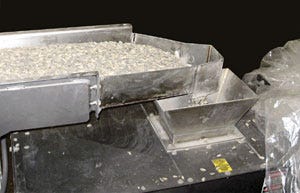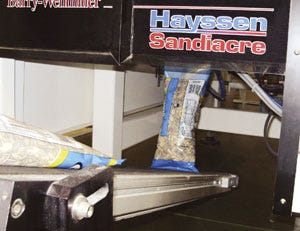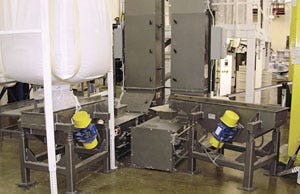March 11, 2015
|
Some people are so hooked on the taste of sunflower seeds, they'd go to great lengths to get them. But they don't really have to search far, because Giant Snacks™, which specializes in such snacking seeds, sells an abundance of them through distributors who sell them to convenience stores across the country. In fact, Giant recently began expanding its marketing of the delectable sunflower seeds into Arizona, New Mexico, California and Texas. Its products are also available online and are shipped throughout the U.S., Canada and internationally. Committed to providing the best seeds possible, Giant dates back to 1958 when Bob Schuler began selecting the absolute best tasting sunflowers for his customers. His company's dedication to quality continues today. Based in Wahpeton, ND, Giant produces sunflower seeds in a rainbow of flavors and varieties, including roasted and salted, spicy garlic, dill pickle, BBQ, salt and pepper, ranch and more, as well as variety and jumbo packs in bags sized from 0.8 to 14 oz.
To process and package more than 2.5 million lb of sunflower seeds each year and meet growing demand, Giant operates its packaging facility in two eight-hr shifts, five days a week. “Sunflower seeds are a health-promoting snack, with significant amounts of Vitamin E,” points out Al Engstrom, plant manager at Giant Snacks. “Quality assurance is important throughout the production process to make sure that shells aren't broken or dirty, and have a firm texture. And all of our film laminate bags are nitrogen-flushed to assure shelf freshness.”
Enhancing productivity
|
The seeds are released from bulk sacks to the feeders, above, which use propulsion energy to smothly and gently convey the seeds to a bucket elevator system with a bucket and chain design, below. The poly propylene buckets are positioned horizontally throughout the packaging circuit until the point of discharge. |
|
For Giant, packaging the seeds accurately and efficiently is just as important as selecting them, says Engstrom. That's why a top priority for the company was to automate its two integrated packaging lines in order to increase productivity. To close its production loop, in January 2008, Giant added twin Model 10-66 vibratory feeders from Gough Econ (www.goughecon.com) to automatically feed the sunflower seeds running on a production line that's also equipped with a pair of Gough Econ “S” Series Swinglink™ bucket elevators. Engstrom notes that automating this part of the operation has helped Giant to meet productivity and quality goals.
The bagging operation begins at a dispensing station, where bulk dispensing Supersacks (from Giant's roasting supplier) containing up to 1,300 lb of the roasted seeds are hung over the twin vibratory feeders. An opening on the bottom of the sacks allows them to deposit the seeds onto vibratory feeders that transport at an average rate of 3,000 lb/hr. Constructed with stainless-steel contact surfaces, the feeders each incorporate four coil springs on their frame assemblies that help minimize vibration transfer and gently handle the seeds with minimal breakage.
Says Gough Econ's vp of sales Andy Leitch, the product weight is typically in suspension, so self-propulsion energy is used in the operation for added efficiency. “Under vibration, the seeds are suspended as the feeder unit runs at five Gs and the product comes back under gravity at one G,” he says. “Basically, the product is in the air four-fifths of the time.” Dual motors on the feeders operate using a minimum of amps (0.9).
Measuring 10 in. wide and 66-in. long, the vibratory feeders or screens are typically used when applications are beyond the scope of an electromagnetic drive and in particular when units require lengths in excess of 5 ft and widths greater than 18 in., according to Gough Econ.
Engstrom notes that the feeders have added reliability and flexibility to the production lines and gentle handling. He also says the feeders operate using a minimum of power.
Swing-bucket elevation
The feeders discharge the seeds to the S Series bucket elevators. With a patented chain and bucket design, the Swinglink elevator system consists of 180 nine-in.-wide polypropylene buckets, each impregnated with a glass fiber resin to prevent staining and allow the company to easily change product flavors—a key criteria of Giant's, which markets a large line of SKUs.
|
Seeds are discharged over the end of the buckets to a hopper and are then fed to weigh scales before progressing to a bag form/fill/seal machine which works with a gas-flushing system. |
The buckets are positioned horizontally and remain so throughout the packaging circuit, except at the point of discharge. From there, the seeds are pneumatically discharged over the end of each bucket into a hopper and are gravity-fed into Yamato Data Weight Sigma Plus Series weigh scales, which are part of a Ultima ST Panel View 600 Model 12-19 bag form/fill/seal machine from Hayssen/Sandiacre (www.hayssensandiacre.com), which works with a gas-flushing system from Parker (www.parker-nni.com) and barrier film bagstocks from Outlook Group (www.outlookgroup.com). Maintaining the buckets in a horizontal position keeps them overlapped to prevent product spillage. The lines run at speeds of up to 60 bags/min, Engstrom reports.
The Swinglink bucket system incorporates a heavy-duty, carbon-steel chain designed for durability and reliability. The chain has a 1.5-in. pitch, and the track on which the chain rides is made of folded stainless steel. The finish is an air-dry Steel-It™ polyurethane. “This design ensures that the seeds are free-falling from the buckets and also prevents spillage,” explains Engstrom. “The buckets have a smooth surface that eliminates trap areas and provides an excellent means of transfer into a single plane.”
Access panels allow each bucket to be cleaned easily with soap and water. Due to its patented chain and bucket design, the elevator system can move the seeds in vertical and horizontal movements without damaging or spilling them.
|
Bulk sacks containing up to 1,300 lb of sunflower seeds, far left, deposit the seed onto the twin vibratory feeders, which then gently transport them using vibration to a pair of bucket elevators, background. The feeders use a minimum of power. |
The scales have 14 heads, each of accommodating weights from 0.8 to 14 oz. When the weight is selected, the bag is filled and sealed.
After the bags are sealed, they are case-packed both manually and on equipment from Fallas Automation (www.fallasautomation.com) in counts from 12 to 72 bags. Next, the cases run through a 3M (www.3m.com) 3M-Matic taper to be sealed. The cases are also bar-coded with a package quantity, a Julian date code, the time packed and who packed them (if applicable) on a Markem-Imaje (www.markem-imaje.com) case coder.
Seeds of content
According to Engstrom, Giant Snacks is pleased with its materials handling equipment additions. “The Gough Econ units are a major part of our automation process and have been operating flawlessly,” he sums up. “We had an immediate return on our equipment investment. Gough Econ's support has been excellent.”
More information is available: |
Gough Econ, 800/264-6844. www.goughecon.com. |
Fallas Automation, 254/772-9524. www.fallasautomation.com. |
Hayssen/Sandiacre, 864/486-4000. www.hayssensandiacre.com. |
Markem-Imaje Corp., 800/258-5356. www.markem-imaje.com. |
Outlook Group, 920/727-7999. www.outlookgroup.com. |
Parker, 410/636-7200. www.parker-nni.com. |
3M Co., 888/364-3577. www.3m.com. |
About the Author(s)
You May Also Like







